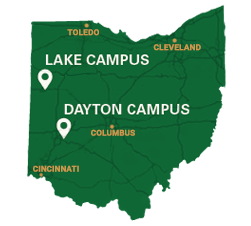Assessment Resources
On this page:
- Assessment Terminology
- Writing Outcomes & Objectives
- Creating Assessment Plans & Identifying Measures
- Mapping Curriculum & Outcomes
- Analyzing Outcome Measurements
- Drawing Outcomes Conclusions
Assessment Terminology Used at Wright State
Many institutions, programs, and accreditors use a variety of terms that often mean the same thing. To that end, the following terms are used centrally at Wright State University within the assessment cycle.
Actions – Data-informed improvements to academic courses or curricula, or other student learning experiences. To be effective, action identification should include specifically what is to be done, by whom (role or committee), and by when.
Analysis (measurement level) – interpretation of meaning from the outcomes measurement results.
Conclusion (outcome level) – drawn from multiple measures for an individual outcome to consider if the learning outcome was sufficiently achieved by students.
Learning Objective – describes the educator’s goals for the learning that will take place in a course or program relative to the educator’s intentions and planned instruction. Objectives are phrased as “Students will…” The Higher Learning Commission refers to learning objectives as goals in Criterion 3.A.
Learning Outcome – describes the learning a student achieves in the course or program. It is a specific and measurable skill, ability, knowledge, belief, or attitude. Outcomes are phrased as “Students can…”
Measure or Measurement – defines the mechanism used to determine if students achieve a specific learning outcome. Measurement definitions describe how it reflects the learning outcome, the method of measurement and evaluation of learning, and a target or benchmark.
Results – include a qualitative and/or quantitative summary of information that results from measurement evaluation. Results are defined by the target and/or benchmark within the measurement definition.
Target or Benchmark – identifies the level at which students, both individually (generally benchmark) and corporately (generally target), meet the expectation of learning. For example, 80% of the group (course enrollment, program completers) will achieve 75% or greater on the multiple-choice assessment (individual achievement).
Writing Outcomes & Objectives
- Student Learning Outcomes
- Writing Outcomes & Objectives workshop slides (PDF)
- Wright State University Guide to Accreditation & Assessment (PDF)
- Differentiating learning outcome rigor across a curriculum or between program levels
- Bloom’s Taxonomy Action Verbs (PDF)
- NACE Career Competencies (NACE)
- Workplace Basics: The Competencies Employers Want (Center for Education & the Workforce)
Creating Assessment Plans & Identifying Measures of Student Learning
- Planning Your Course Level Assessment (PDF)
- Setting Student Learning Benchmarks & Targets (PDF)
- Direct Measures (Washington State University)
- Indirect Measures (Washington State University)
Mapping Curriculum & Outcomes
- Mapping Outcomes & Curriculum workshop slides (PDF)
Analyzing Measurement Results
- Guiding Questions to Analyze Measurement Results (PDF)
- Closing the Loop workshop slides (PDF)
Drawing Outcomes Conclusions
- Guiding Questions to Draw Outcomes Conclusions (PDF)
- Closing the Loop workshop slides (PDF)

